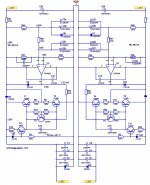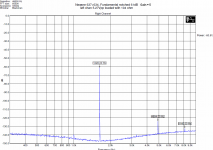OPA671
(I asked my thumb)
You got it!
Needed high impedance FET input, fast opamp with good transient response, about 20 years ago. This was a clear winner and it worked perfectly. For audio, it would have rather high 1/F noise, with corner at above 1kHz. Anyway, I would give it a try, if I had one.
To keep a balance, there was an AD part I loved and used a lot, though not for audio:
An externally hosted image should be here but it was not working when we last tested it.
Last edited:
Anyway
PS audio in Boulder manufactured a preamp model from '94 to '96, based on the OPA671 (OPA604 in the updated model)
Attractive front panel layout, but not a good sounding preamplifier.
It often appears as, in the eyes of marketing managers, technical innovation is using the latest parts, whatever the merits.
Randy Patton, Harvard grad and owner of PS audio in the 1990s, sells production lines for beer cans nowadays (also in Boulder, a man's gotta eat)
Go for it, Karl, I for one would examine them closely; and see what showed up ...
Thanks Frank. Hopefully I'll do them later this afternoon.
I didn't have a problem getting a deep null with DiffMaker. Just have to line them up right.
FWIW, I have seen a few opamp implementations that have benign distortion below 2KHz - but above that things get nasty. Sometime distortion will rise below 250Hz as well. Those are places to look for differences.
FWIW, I have seen a few opamp implementations that have benign distortion below 2KHz - but above that things get nasty. Sometime distortion will rise below 250Hz as well. Those are places to look for differences.
FWIW, I have seen a few opamp implementations that have benign distortion below 2KHz - but above that things get nasty. Sometime distortion will rise below 250Hz as well. Those are places to look for differences.
Yes, but in both cases such parts are not worth trying. Especially those with LF thermal distortion.
To me the "lowest end" acceptable part for audio is OPA134.
My bad, 711 instead
AD711 is nothing to call home about. It is much better to go for AD744, in case we prefer to remain in opamp's stone age.
Yes, but in both cases such parts are not worth trying. Especially those with LF thermal distortion.
To me the "lowest end" acceptable part for audio is OPA134.
Yes, this part can work pretty well and is fairly robust - not much RF interference and good drive capability.
Recently switched to LM4562, won't look back, although more susceptible to RF so needs shielded casing. It is mainly for xovers for active speakers, and to get rid of ground currents properly imo is even more important than which opamp to choose. On the whole I guess a properly implemented NE553x will outperform a haphazerdly applied super opamp hands down.
JJ once mentioned that Calculus was an EE senior year subject at the college near his home.
Wow. It was taught senior year in my high school to the advanced class. Not me, I took it freshman year at Whatsamatta U.
Never. I was the hopeless case that day, wrapped the hand up and went to dinner before the emergency room. Nerves were cut clean through.
PVC electrical tape and paper towel, adjustable tourniquet. Don't leave home without it.
But is that what is really happening? ... methinks a bit more scrounging around is necessary ...
I'd look at the possibility that internal nodes are current starving. I've also no idea what the thermal time constants are for the small chips inside.Yes, but in both cases such parts are not worth trying. Especially those with LF thermal distortion.
jn
AD711 is nothing to call home about. It is much better to go for AD744, in case we prefer to remain in opamp's stone age.
I provided the internal points to both bypass the Neanderthal pnp or bypass the whole output stage and custom compensate. I'm sure Walt and I published something somewhere, you could cobble together a pretty nice line stage even today. BTW stills sells at $1M/annum.
Go for it, Karl, I for one would examine them closely; and see what showed up ...
Frank, these are the raw Audacity files for four separate runs of the track. (if you want just audio then I can do that later... out of time today
They should be "identical" if aligned and examined. The player and PC had been on for an hour or so and so no real clock drift to speak of.
Difference Files
Recently switched to LM4562, won't look back, although more susceptible to RF so needs shielded casing.
Exactly! The RF susceptibility of the LM4562 is quite high. JFET opamps are less susceptible in general. What is interesting, that NE5534/2 is much less susceptible to RF than LM4562. One of the best performing BJT opamps regarding RFI is AD797.
in case we prefer to remain in opamp's stone age.
Other OPA604 use of the '90s.

Attachments
As we were discussing distortion of loaded opamps and buffers, this is the best result I have measured so far. It is for OPA637+BUF634T, overall gain = 5, loaded with 104 ohm. The result for AD797+BUF634T in the same circuit was approaching to this one, but slightly worse.
Attachments
Nelson, would you mind telling what you faulted it
(OPA604) for enough to discard it?
I'm sorry, but my memory isn't that great. We had them because Wayne
was using them for housekeeping on a preamp, so I set up one as a line
stage and it didn't sound good. I wanted to like it, and I screwed around
with it for a couple of days, and then moved on. Its THD measured OK.
Was it the "error correction block" or the phase splitter driving the NPN
output stage, or just me? I don't know.
To me the "lowest end" acceptable part for audio is OPA134.
That's interesting. I tried the OPA2134 in my amp which uses two stages, both inverting. I wanted to like it, convinced myself it was better (than the OPA2604 fitted) and lived with it for many months. During that period the amp was just not as enjoyable to listen to.
Recently switched to LM4562, won't look back, although more susceptible to RF so needs shielded casing.
That is what I switched to over 12 months ago now. Pretty faultless imo.
Interesting idea. How would one check?I'd look at the possibility that internal nodes are current starving.
It is surprising how many here change back and forth from bipolar input to jfet input without resolving WHERE the part will be used. For me, anything over 2K input drive will most probably be jfet input. However for 1K and less, then bipolar input is usually quieter by a large margin.
This is one of the reasons why I stay with discrete designs, because I can get very low noise jfets that will work well with just about any input impedance used in a phono or line amp.
I do agree with everyone that buffering or at least modifying the IC output stage can give better results, and that was the original premise or warning
that we all have to watch out for, i.e. loading the output stages of many IC op amps too much, for whatever reason.
This is one of the reasons why I stay with discrete designs, because I can get very low noise jfets that will work well with just about any input impedance used in a phono or line amp.
I do agree with everyone that buffering or at least modifying the IC output stage can give better results, and that was the original premise or warning
that we all have to watch out for, i.e. loading the output stages of many IC op amps too much, for whatever reason.
- Status
- Not open for further replies.
- Home
- Member Areas
- The Lounge
- John Curl's Blowtorch preamplifier part II

